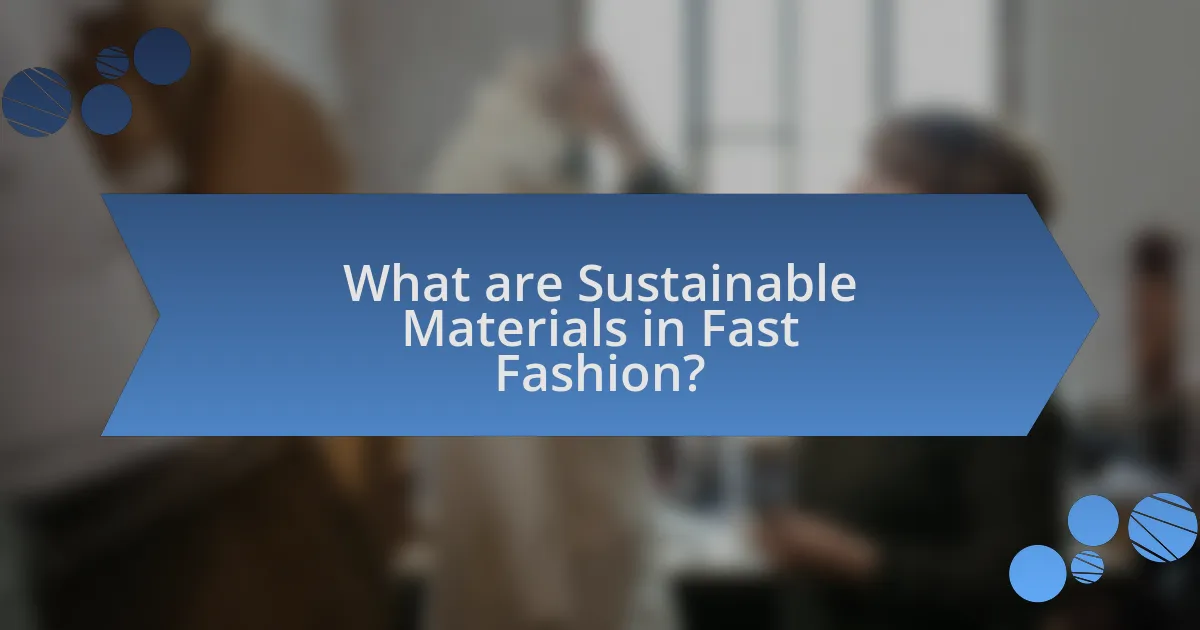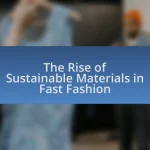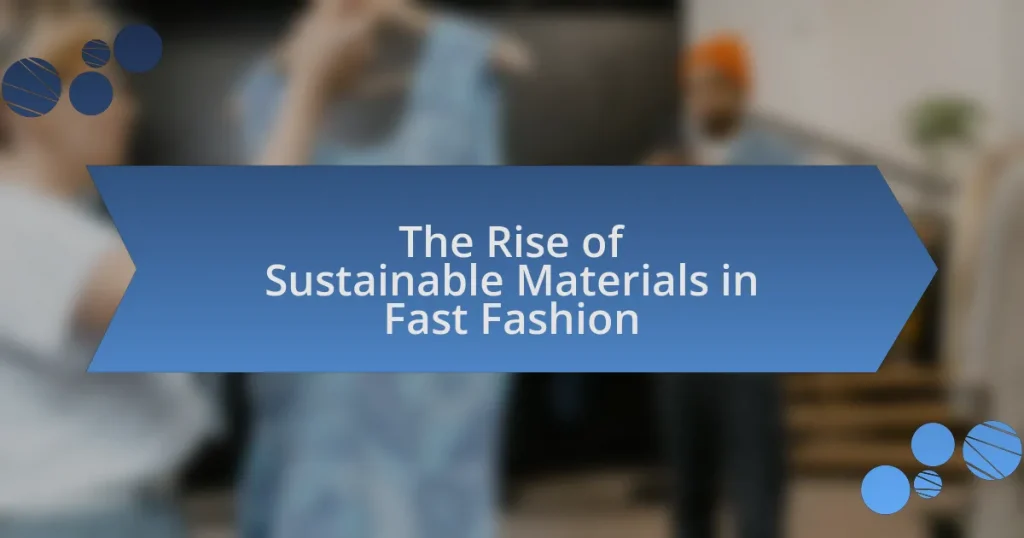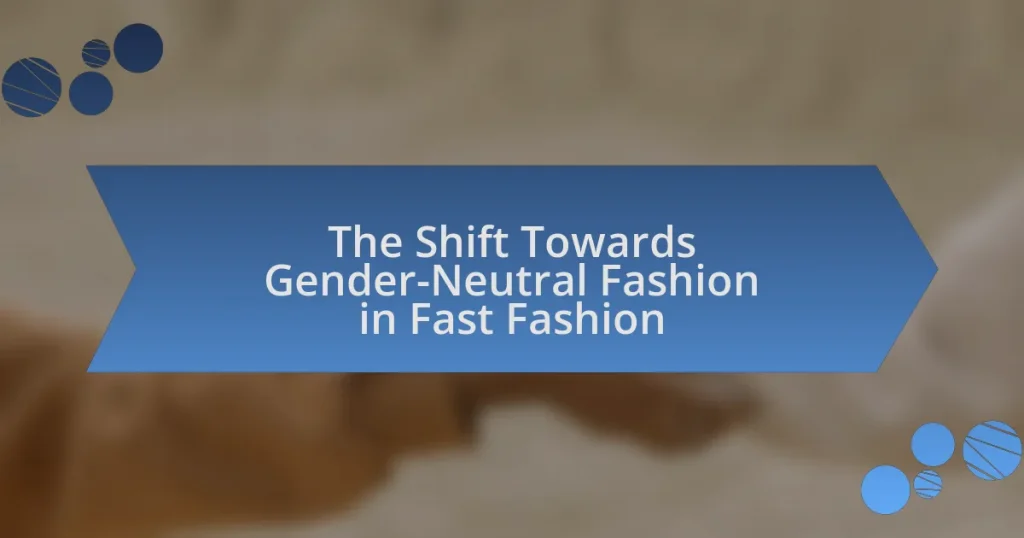The article focuses on the rise of sustainable materials in fast fashion, highlighting textiles produced with minimal environmental impact and social responsibility, such as organic cotton, recycled polyester, Tencel, and hemp. It contrasts sustainable materials with traditional options, emphasizing their reduced ecological footprint and the growing consumer demand for eco-friendly products. Key characteristics of sustainable materials, the challenges brands face in adopting them, and successful case studies of brands implementing these practices are discussed. The article also explores the role of consumer preferences and education in driving the trend towards sustainability in the fashion industry.

What are Sustainable Materials in Fast Fashion?
Sustainable materials in fast fashion are textiles that are produced with minimal environmental impact and promote social responsibility. These materials often include organic cotton, recycled polyester, Tencel, and hemp, which are sourced or manufactured in ways that reduce water usage, chemical pollution, and carbon emissions. For instance, organic cotton is grown without synthetic pesticides and fertilizers, while recycled polyester is made from post-consumer plastic bottles, diverting waste from landfills. The adoption of these materials is driven by the fashion industry’s increasing awareness of its ecological footprint and consumer demand for more ethical production practices.
How do sustainable materials differ from traditional materials in fast fashion?
Sustainable materials differ from traditional materials in fast fashion primarily by their environmental impact and resource sourcing. Traditional materials, such as conventional cotton and polyester, often rely on harmful agricultural practices and petroleum-based processes, contributing to pollution and resource depletion. In contrast, sustainable materials, like organic cotton, Tencel, and recycled polyester, are produced using methods that minimize environmental harm, such as reduced water usage and lower carbon emissions. For instance, organic cotton farming uses natural pesticides and fertilizers, which decreases soil and water contamination. Additionally, sustainable materials often incorporate recycled content, reducing waste and the need for virgin resources. This shift towards sustainability is supported by a growing consumer demand for eco-friendly products, with a report from McKinsey indicating that 67% of consumers consider sustainability when making a purchase.
What are the key characteristics of sustainable materials?
Sustainable materials are characterized by their ability to minimize environmental impact, promote resource efficiency, and support social equity. These materials are often derived from renewable resources, such as organic cotton or bamboo, which reduce reliance on finite resources. Additionally, sustainable materials are designed for durability and recyclability, ensuring that they can be reused or repurposed at the end of their life cycle, thus reducing waste. Furthermore, they are produced through processes that limit pollution and energy consumption, often adhering to certifications like Global Organic Textile Standard (GOTS) or OEKO-TEX, which validate their sustainability claims.
Why is the choice of materials important in fast fashion?
The choice of materials is crucial in fast fashion because it directly impacts environmental sustainability, consumer health, and product quality. Fast fashion brands often prioritize low-cost, synthetic materials that contribute to pollution and waste, as evidenced by the fact that the fashion industry is responsible for 10% of global carbon emissions. Additionally, the use of harmful chemicals in these materials can pose health risks to consumers. Sustainable materials, such as organic cotton or recycled polyester, not only reduce environmental harm but also enhance the longevity and appeal of garments, aligning with growing consumer demand for eco-friendly products.
What are the main types of sustainable materials used in fast fashion?
The main types of sustainable materials used in fast fashion include organic cotton, Tencel (lyocell), recycled polyester, and hemp. Organic cotton is grown without synthetic pesticides or fertilizers, reducing environmental impact. Tencel, made from sustainably sourced wood pulp, is biodegradable and produced in a closed-loop process that recycles water and solvents. Recycled polyester, derived from post-consumer plastic bottles, helps reduce waste and energy consumption compared to virgin polyester. Hemp is a fast-growing crop that requires minimal water and pesticides, making it an eco-friendly alternative. These materials collectively contribute to reducing the ecological footprint of the fast fashion industry.
What are organic fabrics and how are they used?
Organic fabrics are textiles made from fibers grown without the use of synthetic pesticides, fertilizers, or genetically modified organisms. These fabrics, such as organic cotton, linen, and hemp, are used in various applications including clothing, home textiles, and accessories, promoting sustainability in the fashion industry. The use of organic fabrics reduces environmental impact by minimizing chemical runoff and promoting biodiversity, aligning with the growing consumer demand for eco-friendly products in fast fashion.
How do recycled materials contribute to sustainability?
Recycled materials contribute to sustainability by reducing the demand for virgin resources, thereby conserving natural resources and minimizing environmental impact. For instance, using recycled plastics in manufacturing can save up to 66% of energy compared to producing new plastics from petroleum. Additionally, recycling diverts waste from landfills, which helps decrease greenhouse gas emissions associated with waste decomposition. According to the Environmental Protection Agency, recycling and composting prevented the release of approximately 186 million metric tons of carbon dioxide equivalent into the air in 2018, demonstrating the significant role recycled materials play in mitigating climate change.
Why is there a growing demand for sustainable materials in fast fashion?
There is a growing demand for sustainable materials in fast fashion due to increasing consumer awareness of environmental issues and the negative impact of traditional textile production. Consumers are now prioritizing eco-friendly options, leading brands to adopt sustainable practices to meet this demand. For instance, a 2021 survey by McKinsey & Company found that 67% of consumers consider the use of sustainable materials as an important factor in their purchasing decisions. This shift is also driven by regulatory pressures and the need for brands to enhance their corporate social responsibility, further solidifying the trend towards sustainability in the fashion industry.
What role do consumer preferences play in this trend?
Consumer preferences significantly drive the trend of sustainable materials in fast fashion. As consumers increasingly prioritize environmental sustainability, brands are compelled to adapt their offerings to meet these expectations. A 2021 survey by McKinsey & Company found that 67% of consumers consider sustainability when making a purchase, indicating a clear shift towards eco-friendly products. This demand influences brands to invest in sustainable materials, such as organic cotton and recycled polyester, to attract and retain customers. Consequently, consumer preferences not only shape product development but also encourage the entire industry to adopt more sustainable practices.
How does environmental awareness influence the fashion industry?
Environmental awareness significantly influences the fashion industry by driving the adoption of sustainable practices and materials. As consumers increasingly prioritize eco-friendly products, brands are compelled to innovate and incorporate sustainable materials, such as organic cotton and recycled polyester, into their collections. For instance, a 2021 McKinsey report highlighted that 67% of consumers consider the use of sustainable materials important when making purchasing decisions. This shift not only enhances brand reputation but also aligns with regulatory pressures and market trends favoring sustainability, ultimately reshaping production processes and supply chains within the industry.

What challenges do brands face in adopting sustainable materials?
Brands face significant challenges in adopting sustainable materials, primarily due to cost, supply chain complexities, and consumer demand. The financial implications of sourcing sustainable materials often exceed those of conventional options, making it difficult for brands to maintain competitive pricing. Additionally, the supply chain for sustainable materials can be less developed, leading to issues with availability and consistency in quality. Furthermore, consumer awareness and demand for sustainable products can vary, complicating brands’ ability to justify the transition to sustainable materials. According to a 2021 McKinsey report, 66% of consumers are willing to pay more for sustainable brands, yet many brands struggle to align their offerings with this demand while managing the associated costs and logistical challenges.
How do cost factors impact the use of sustainable materials?
Cost factors significantly influence the adoption of sustainable materials in fast fashion by affecting production choices and pricing strategies. High initial costs associated with sustainable materials, such as organic cotton or recycled polyester, often deter brands from integrating them into their supply chains, as these materials can be more expensive than conventional alternatives. For instance, a report by McKinsey & Company indicates that sustainable materials can increase production costs by 10% to 30%, which impacts profit margins and pricing for consumers. Consequently, brands may prioritize cheaper, non-sustainable options to maintain competitive pricing, limiting the overall market penetration of sustainable materials.
What are the financial implications for brands transitioning to sustainable materials?
Brands transitioning to sustainable materials often face increased initial costs but can benefit from long-term financial gains. The shift to sustainable materials typically involves higher production costs due to sourcing and manufacturing processes, which can lead to a temporary decrease in profit margins. However, as consumer demand for eco-friendly products rises, brands can capitalize on this trend by attracting a growing segment of environmentally conscious consumers, potentially increasing sales and market share.
For instance, a study by McKinsey & Company found that 67% of consumers consider sustainability when making a purchase, indicating a significant market opportunity for brands that invest in sustainable practices. Additionally, brands that adopt sustainable materials may experience reduced regulatory risks and improved brand loyalty, which can enhance their financial stability over time.
How do supply chain issues affect the availability of sustainable materials?
Supply chain issues significantly reduce the availability of sustainable materials by disrupting the flow of resources needed for production. For instance, delays in transportation, shortages of raw materials, and increased costs can hinder manufacturers’ ability to source eco-friendly materials like organic cotton or recycled polyester. According to a report by McKinsey & Company, supply chain disruptions during the COVID-19 pandemic led to a 30% decrease in the availability of sustainable materials in the fashion industry. This reduction impacts brands’ commitments to sustainability, as they struggle to meet consumer demand for environmentally friendly products.
What are the technological barriers to using sustainable materials?
The technological barriers to using sustainable materials include limitations in production processes, scalability issues, and insufficient infrastructure for recycling. These barriers hinder the widespread adoption of sustainable materials in industries like fast fashion. For instance, many sustainable materials require advanced manufacturing techniques that are not yet fully developed or commercially viable, leading to higher costs and lower efficiency compared to conventional materials. Additionally, the lack of established recycling systems for these materials complicates their lifecycle management, making it difficult to integrate them into existing supply chains. According to a report by the Ellen MacArthur Foundation, only 1% of clothing is recycled into new clothing, highlighting the urgent need for technological advancements in recycling processes to support sustainable practices in the fashion industry.
How does innovation in material science affect sustainability in fashion?
Innovation in material science significantly enhances sustainability in fashion by enabling the development of eco-friendly fabrics and production processes. For instance, advancements in bio-based materials, such as those derived from agricultural waste or recycled plastics, reduce reliance on petroleum-based fibers, which are harmful to the environment. According to a report by the Ellen MacArthur Foundation, transitioning to sustainable materials could reduce fashion’s greenhouse gas emissions by 44% by 2030. Furthermore, innovations like waterless dyeing techniques and closed-loop recycling systems minimize water usage and waste, further contributing to a more sustainable fashion industry.
What are the limitations of current sustainable material technologies?
Current sustainable material technologies face several limitations, including high production costs, limited scalability, and performance issues compared to conventional materials. For instance, many sustainable materials, such as bio-based plastics or organic cotton, often require more resources or advanced processing techniques, leading to increased costs that can hinder widespread adoption in the fast fashion industry. Additionally, the scalability of these technologies is often restricted due to the availability of raw materials and the infrastructure needed for production. Performance-wise, sustainable materials may not always meet the durability and aesthetic standards expected by consumers, which can limit their acceptance in a market driven by trends and fast turnover. These factors collectively challenge the integration of sustainable materials into mainstream fast fashion.

How are brands successfully implementing sustainable materials in fast fashion?
Brands are successfully implementing sustainable materials in fast fashion by integrating recycled fabrics, organic cotton, and innovative textiles derived from renewable resources into their product lines. For instance, companies like H&M and Zara have launched collections that utilize recycled polyester made from plastic bottles, significantly reducing waste and resource consumption. Additionally, brands are adopting certifications such as Global Organic Textile Standard (GOTS) to ensure that their organic cotton is sourced sustainably. According to a 2021 report by McKinsey & Company, the use of sustainable materials can reduce the environmental impact of fashion by up to 30%, demonstrating the effectiveness of these strategies in promoting sustainability within the fast fashion industry.
What strategies are brands using to integrate sustainable materials?
Brands are integrating sustainable materials through strategies such as sourcing recycled fabrics, utilizing organic materials, and implementing circular economy practices. For instance, companies like H&M and Adidas have launched collections made from recycled plastic bottles and organic cotton, significantly reducing their environmental impact. Additionally, brands are adopting life cycle assessments to evaluate the sustainability of materials, ensuring that their sourcing aligns with eco-friendly standards. This approach not only meets consumer demand for sustainable products but also helps brands comply with increasing regulations on environmental sustainability.
How do collaborations with sustainable material suppliers work?
Collaborations with sustainable material suppliers involve partnerships where fashion brands source eco-friendly materials to reduce environmental impact. These collaborations typically begin with brands identifying suppliers that specialize in sustainable practices, such as using organic fibers or recycled materials. The brands then negotiate terms, ensuring that the materials meet their design and quality standards while adhering to sustainability criteria.
For instance, a fashion brand may partner with a supplier that produces organic cotton, which is grown without harmful pesticides, thus minimizing ecological damage. This partnership not only enhances the brand’s sustainability profile but also appeals to environmentally conscious consumers. According to a report by McKinsey & Company, 67% of consumers consider sustainability when making a purchase, highlighting the importance of such collaborations in the fast fashion industry.
What role does consumer education play in successful implementation?
Consumer education plays a crucial role in the successful implementation of sustainable materials in fast fashion by informing consumers about the environmental and social impacts of their purchasing decisions. Educated consumers are more likely to demand transparency and sustainability from brands, which drives companies to adopt eco-friendly practices. For instance, a study by the Ellen MacArthur Foundation highlights that informed consumers can significantly influence market trends, leading to a 30% increase in demand for sustainable products when they understand their benefits. This demonstrates that consumer education not only empowers individuals but also catalyzes industry-wide changes towards sustainability.
What are some successful case studies of sustainable materials in fast fashion?
Some successful case studies of sustainable materials in fast fashion include H&M’s Conscious Collection, which utilizes organic cotton and recycled polyester, and Stella McCartney’s use of vegan leather and sustainable fabrics. H&M reported that their Conscious Collection has significantly reduced water usage and carbon emissions compared to conventional materials. Stella McCartney’s commitment to sustainability has led to the development of innovative materials like Mylo, a mushroom-based leather alternative, showcasing the potential for eco-friendly options in the industry. These examples illustrate the effectiveness of integrating sustainable materials into fast fashion, contributing to reduced environmental impact.
Which brands are leading the way in sustainable material usage?
Patagonia, Stella McCartney, and H&M are leading the way in sustainable material usage. Patagonia utilizes recycled materials in its products, with over 69% of its materials being recycled or organic as of 2021. Stella McCartney is known for its commitment to vegan and sustainable fabrics, often using organic cotton and recycled polyester. H&M has launched its Conscious Collection, which incorporates organic and recycled materials, aiming for 100% sustainable cotton by 2025. These brands exemplify the shift towards environmentally responsible practices in the fashion industry.
What lessons can be learned from these successful implementations?
Successful implementations of sustainable materials in fast fashion demonstrate that integrating eco-friendly practices can enhance brand reputation and consumer loyalty. Companies like H&M and Stella McCartney have shown that prioritizing sustainability not only meets growing consumer demand for ethical products but also leads to increased sales; for instance, H&M reported a 38% increase in sales of its Conscious Collection. Additionally, these implementations highlight the importance of transparency in supply chains, as consumers are more likely to support brands that openly share their sustainability efforts. This trend indicates that businesses can achieve competitive advantages by adopting sustainable practices, ultimately contributing to a more responsible fashion industry.
What practical steps can consumers take to support sustainable materials in fast fashion?
Consumers can support sustainable materials in fast fashion by choosing brands that prioritize eco-friendly practices and materials. This includes researching companies that use organic cotton, recycled polyester, or other sustainable fabrics, as well as checking for certifications like Global Organic Textile Standard (GOTS) or OEKO-TEX. Additionally, consumers can reduce their overall consumption by buying fewer, higher-quality items that last longer, thus minimizing waste. Engaging in second-hand shopping or clothing swaps also promotes sustainability by extending the life cycle of garments. According to a 2021 report by McKinsey & Company, sustainable fashion can significantly reduce environmental impact, highlighting the importance of consumer choices in driving industry change.













